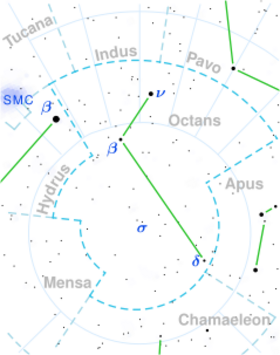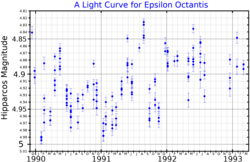Astronomy:Epsilon Octantis
| Observation data Equinox J2000.0]] (ICRS) | |
|---|---|
| Constellation | Octans |
| Right ascension | 22h 20m 01.67970s[1] |
| Declination | −80° 26′ 23.0947″[1] |
| Apparent magnitude (V) | 4.58 - 5.30[2] |
| Characteristics | |
| Spectral type | M5III[3] |
| U−B color index | +1.18[4] |
| B−V color index | +1.47[4] |
| Variable type | SRb[2] |
| Astrometry | |
| Radial velocity (Rv) | +11.70[5] km/s |
| Proper motion (μ) | RA: +56.81[1] mas/yr Dec.: −43.47[1] mas/yr |
| Parallax (π) | 11.22 ± 0.23[1] mas |
| Distance | 291 ± 6 ly (89 ± 2 pc) |
| Absolute magnitude (MV) | +0.34[6] |
| Details | |
| Mass | 1.34[7] M☉ |
| Radius | 112±15[8] R☉ |
| Luminosity | 1,819[8] L☉ |
| Surface gravity (log g) | 2.15[7] cgs |
| Temperature | 3,560±264[8] K |
| Other designations | |
| Database references | |
| SIMBAD | data |
Epsilon Octantis, Latinized from ε Octantis, is a star in the southern circumpolar constellation of Octans. It is a faintly visible to the naked eye with an apparent visual magnitude of about 5. The annual parallax shift of 11.22[1] mas yields a distance estimate of around 291 light years. It is moving further from the Sun with a radial velocity of +11.7 km/s.[5]
This is an evolved, cool red giant star with a stellar classification of class M5III.[3] It is a semiregular variable with a magnitude range of 4.58 to 5.30 and a (poorly defined) period around 55 days.[2] The star has 1.34[7] times the mass of the Sun and has expanded to around 112[8] times the Sun's radius. It is radiating 1,819[8] times the Sun's luminosity from its enlarged photosphere at an effective temperature of 3,560 K.[8]
Epsilon Octantis was found to be variable on a survey of the southern sky conducted by the Bamberg observatory, which was reported in 1966.[10] In 1972, it was assigned the variable star designation BO Octantis,[11] although this is now recognised as a mistake since stars with Bayer designations are not given a separate variable star designation.[2]
References
- ↑ 1.0 1.1 1.2 1.3 1.4 1.5 Van Leeuwen, F. (2007). "Validation of the new Hipparcos reduction". Astronomy and Astrophysics 474 (2): 653–664. doi:10.1051/0004-6361:20078357. Bibcode: 2007A&A...474..653V. Vizier catalog entry
- ↑ 2.0 2.1 2.2 2.3 Samus, N. N. et al. (2009). "VizieR Online Data Catalog: General Catalogue of Variable Stars (Samus+ 2007-2013)". VizieR On-line Data Catalog: B/GCVS. Originally Published in: 2009yCat....102025S 1. Bibcode: 2009yCat....102025S.
- ↑ 3.0 3.1 Hoffleit, D.; Warren, W. H. (1995). "VizieR Online Data Catalog: Bright Star Catalogue, 5th Revised Ed. (Hoffleit+, 1991)". VizieR On-line Data Catalog: V/50. Originally Published in: 1964BS....C......0H 5050. Bibcode: 1995yCat.5050....0H.
- ↑ 4.0 4.1 Mermilliod, J. C. (2006). "VizieR Online Data Catalog: Homogeneous Means in the UBV System (Mermilliod 1991)". VizieR On-line Data Catalog: II/168. Originally Published in: Institut d'Astronomie 2168. Bibcode: 2006yCat.2168....0M.Vizier catalog entry
- ↑ 5.0 5.1 Gontcharov, G. A. (2006). "Pulkovo Compilation of Radial Velocities for 35 495 Hipparcos stars in a common system". Astronomy Letters 32 (11): 759–771. doi:10.1134/S1063773706110065. Bibcode: 2006AstL...32..759G.
- ↑ Anderson, E.; Francis, Ch. (2012). "XHIP: An extended hipparcos compilation". Astronomy Letters 38 (5): 331. doi:10.1134/S1063773712050015. Bibcode: 2012AstL...38..331A. Vizier catalog entry
- ↑ 7.0 7.1 7.2 Allende Prieto, C.; Lambert, D. L. (1999). "Fundamental parameters of nearby stars from the comparison with evolutionary calculations: Masses, radii and effective temperatures". Astronomy and Astrophysics 352: 555–562. Bibcode: 1999A&A...352..555A. Vizier catalog entry
- ↑ 8.0 8.1 8.2 8.3 8.4 8.5 Arroyo-Torres, B. et al. (June 2014), "VLTI/AMBER observations of cold giant stars: atmospheric structures and fundamental parameters", Astronomy & Astrophysics 566: 11, doi:10.1051/0004-6361/201323264, A88, Bibcode: 2014A&A...566A..88A
- ↑ "/ftp/cats/more/HIP/cdroms/cats". Strasbourg astronomical Data Center. https://cdsarc.cds.unistra.fr/viz-bin/ftp-index?/ftp/cats/more/HIP/cdroms/cats.
- ↑ Strohmeier, W.; Fischer, H.; Ott, H. (1966). "Bright Southern BV-Stars". Information Bulletin on Variable Stars 120: 1. Bibcode: 1966IBVS..120....1S.
- ↑ Kukarkin, B. V.; Kholopov, P. N.; Kukarkina, N. P.; Perova, N. B. (1 September 1972). "58th Name-List of Variable Stars". Information Bulletin on Variable Stars 717: 1. ISSN 0374-0676. Bibcode: 1972IBVS..717....1K.
 |



